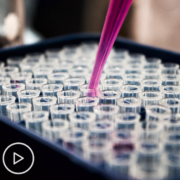CLL Genetic Tests: How Do Results Impact Treatment and Care? from Patient Empowerment Network on Vimeo.
Dr. Danielle Brander reviews the types of genetic tests used in chronic lymphocytic leukemia (CLL) and explains the role the results can play in a patient’s treatment and care.
Dr. Danielle Brander is Director of the CLL and Lymphoma Clinical Research Program at Duke Cancer Institute. Learn more about Dr. Brander here.
See More From Your CLL Navigator
Related Resources
Transcript:
Dr. Brander:
There are many types of what we call genetic or genomic testing in CLL. One point that I think needs to be clarified is unlike other malignancies when sometimes we mention genetic testing, the testing in CLL is not testing of all the cells of your body where you’re looking for any genes that were perhaps inherited to your parents, or in your cells that are passed on to offspring.
Rather, just to clarify from the offset, when we talk about genetic or genomic testing, these are characteristics of the leukemia cells themselves. That is, when it becomes a cancer that’s called CLL, some of its genes can change, and those genes can provide helpful information from the time of diagnosis and what perhaps to expect in the years coming forward. And more and more we use these genomic tests to inform and help amongst your treatment options both as first treatments and if the patient requires subsequent treatment.
There are several different types. Some of them involve looking at whole, duplicate, or missing parts of the chromosome so the material that – what holds the genetic material in the leukemia cells.
And one of the very important of this test is a test called FISH. And FISH probes within the chromosomes to look for common abnormalities that are known to be important in CLL. So it doesn’t look at all the chromosomes, but by probing for specific areas, it makes it much more sensitive to be able to test the cells. And there are different patterns that we can talk about again that won’t change whether patients need treatment or not, but are helpful in knowing what to expect and what the best treatment options may be.
Another important test in CLL is a test called the IGHV mutation status, and that’s a big long word and test, but there are two parts of that. One is mutated and one is unmutated, and it sounds backwards, but patients with mutated IGHV may have a longer time to treatment and can have different responses and duration of responses specific to chemotherapy.
Now with the newer drugs that are available for CLL, another point I just want to make is that these tests were mostly originally studied in the era when we only had chemotherapy or chemoimmunotherapy to offer the patient. So, looking at the results of those studies may not inform completely because with the newer drugs, responses can often be seen even for patients that have what we call the higher-risk changes in FISH or IGHV.
The one other type of test that I’ll mention is looking for a mutation in a gene called TP53. Now by FISH testing, we look for deletions of part of the chromosome in the leukemia cell called deletion 17p. That deletes part of the chromosome that codes for your body, building a protein called TP53.
But patients also can have testing for mutations in TP53, not just the deletion. And again, this might point towards what to expect, but importantly really informs options for treatment moving forward. We won’t have time today to get into all the research tests. Those are some of the standard tests that we do to characterize the CLL after diagnosis, and there might be additional testing at the time of treatment or after relapse, and importantly for patients that are able to be involved in research, there’s many other testing that look at different mutations, though they’re not always part of routine clinical care.
There are a couple ways that the results of these tests can impact overall care and treatment discussions. To review, though, importantly as you meet with your team, the results won’t impact to date when you need treatment. There are certain indications for treatment of CLL, and these right now are independent than the results of the testing. Even if FISH identifies what was historically called a high-risk deletion, such as deletion 17p, that won’t change the recommendations to that patients need treated right away.
However, putting the different markers together may inform your team to help counsel you on what to expect moving forward. There are a couple studies looking at patients with higher-risk changes by FISH or with the IGHV unmutated may need treatment sooner than someone that does not have those changes. So it gives you a little information though still just a prediction of maybe what to expect.
Perhaps the greatest impact, though, is at the time of requiring therapy, and that is because patients with either deletion 17p by FISH, or TP53 mutations should never receive traditional chemoimmunotherapy as the first treatment because patients with this type of CLL are really resistant to chemoimmunotherapy, and the novel agents or clinical trials should be explored.
More and more, the test for IGHV at the time of first treatment can also be helpful in choosing amongst options as there were two recent large clinical trials where half the patients received chemotherapy, half the patients received in that particular trial ibrutinib-based therapy as the first treatment. And for patients with especially IGHV unmutated, the responses were much longer for patients that received the novel therapies. In fact, if you look at patients treated with the novel treatment such as ibrutinib or venetoclax, or next-generation inhibitors, there’s really no difference in response whether patients had mutated or unmutated IGHV and the depth of response.
So, it’s still very individualized discussion because there might be other medical problems patients have or specific other reasons not to use the novel targeted drugs.
But in terms of expectation for response and duration of response, that’s how it can be very helpful.
 CLL Genetic Tests: How Do Results Impact Treatment and Care?
CLL Genetic Tests: How Do Results Impact Treatment and Care? CLL Genetic Testing Explained
CLL Genetic Testing Explained Predictive (Familial) Genetic Testing vs. Cancer Genetic Testing: What’s the Difference?
Predictive (Familial) Genetic Testing vs. Cancer Genetic Testing: What’s the Difference?




